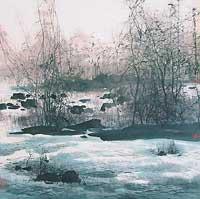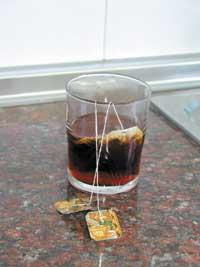Ink, cocktail to write
Losing black does not mean by itself age: The “bad” ink loses black in a few hours. Of course, if you lose it for a few years, the inkjet itself may never know that its ink is of "low quality". In addition, those who analyze it after the years also do not have the last word, since they usually cannot know how the document or the drawing was in its origin. It is not easy, often only experience can solve this problem.

In restoration work, experts know that ink persistence is almost insecure, as many factors intervene in the degradation process. Paper ages spontaneously due to the microorganisms that contain the paper itself and its environment. On the other hand, the chemical composition of the ink is also related, since in one way or another it is "linked" with the paper, in certain compact and durable forms, and in the long run the ink components can attack the paper and destroy the document.
Thus, it seems almost impossible for an ink to remain intact. A document has a red time, right? Instead of trying to turn this argument around, we'll explain what else an ink needs to be ink.
Alcohol with alcohol
In short, liquid ink is a mixture of the pigment and a conveyor. The first gives color and the other only helps to leave the pigment on paper and fix it correctly. It seems simple, but millions of mixes can be tested before a worthy result. Getting a perfect combination is not easy. Let's see why.
The conveyor is usually a solvent. Why not water, a universal solvent? From water-soluble pigments, water can be a good choice, affordable and cheap. However, simple water-based inks have a big problem: water, when coming into contact with paper, spreads on the surface of the paper and, of course, with water goes color. In this way we would get an uncontrolled stain. The problem is water: It is too light. The viscosity of the water is too low and you have to add something else to be a good transporter.

Therefore, another more viscous substance should be used. The correct measurement is difficult as it should not be too viscous; the ink should be liquid, controllable but liquid.
From the point of view of reality, it seems that it is not always true, for many applications a very viscous, sometimes almost solid ink is used. But having to transport the pigment, the ink must have minimal fluidity. Pen ink, for example, contains a polymer between its components, which makes it very viscous, but is not entirely solid.
To be a liquid ink carrier, conventional alcohol, ethanol, seems a good option and that is: many inks are used that dissolve in alcohol. However, this solvent has another problem, its evaporation is very fast, since alcohol is almost evaporated no more write. Therefore, you have little time to properly leave the dye on the paper and also can not be stored in an open container. The opposite is not acceptable either; if liquid ink remains liquid for more than a few seconds, the likelihood of writing being "moved" by hand and dirty is very high. Until recently, the drainer, along with the pen and ink, was used to write anything.
In general, the conveyor of inks is usually a mixture of several alcohols. Ethanol, methanol, isopropanol, ethylene glycol and water are widely used in these mixtures (ethylene glycol is used in many cases as polymerized, and water, although not wanted to be included in the group of alcohols, is usually a good solvent of alcohols). But even by delivering the ingredients of the mixture, it is not easy to know what the proportion of each should be. You have to get a suitable viscosity, not too much, not too little, and also the solvent should evaporate in a few seconds. It is complicated. In the absence of previous recipes, the inkwell must perform many sessions to prepare the appropriate solvent.
War on Degradation
In addition, the craftsman's work does not end in the preparation of pigment and conveyor. If you want to make a sustainable ink, you should take into account the material in which it will be used, since the durability of the ink ultimately depends on the connections it produces with the skin.
Of course, this feature increases the list of components of the writing cocktail. On many occasions, the recipe is rich in additive products such as fungicides and antioxidants. What relationship do these substances have with ink? They are important in the interaction between ink and paper. The main component of paper is cellulose, which degrades over time due to sun, atmosphere and fungi. To avoid this, both paper and ink must be protected.

It is therefore surprising that many historical documents have been preserved. However, ink manufacturers have developed very efficient inks thanks to the experience of the centuries. Let us not forget that instead of starting from laboratory substances, inks have been traditionally made from natural products.
In spite of being known in Roman times, since the Middle Ages are considered habitual inks in iron and tannins. All the necessary materials are easy to find in nature, on the one hand, minerals containing iron salts are very abundant and on the other, tannins are easily extracted from oaks or grapes. Once mixed in water, both substances react to each other and oxidize by air action. As a result a ferric tanate is formed, the black color of the ink. The inkwell just needed to mix both substances and wait to get the ink. To improve the process was added the Arabic gum brought by the east, which was extracted from pineapples and dissolved in water. Due to the effect of the rubber, the ink acquired the necessary consistency to write and, in addition, helped to stick it on the paper. Finally, sometimes the inkwell had to filter the mixture. The cocktail thus obtained, in general, is too acidic for today's role and generates long-term corrosion problems. However, this cocktail has undoubtedly been a precious asset until recently. |

They got it: among the types of inks that have long been known, there is one that does not lose the blackness, the Chinese ink. It is a mysterious, valuable liquid. During use, the draftsman (or writer) can add the water he wants, obtaining millions of gray tones, including gradients. But once dry the ink does not dissolve in water. The dry ink becomes resistant to water and not only to water, the light also does not act and not being an acidic ink does not attack the paper. The work seems to last forever.
The secret lies in charcoal: ink is a dispersion of tiny particles of coal. To do this, the inkwell bred the soot and heated it in a tail extracted from the stripes. The material obtained had to be beaten in the almerete until it could be collected in bars. That bar dissolves in the water when the artist used it to get a total black or a desired gray.
- (Photo: G. Roa).Fill the glass of water to half, boil and add two tea bags. You will get a very concentrated tea infusion, it has the tannins you need!

- Once the tea has cooled, add the baking soda. Chemical reaction that forms sodium tanate.
- The next morning you will have a very fluid ink, but it can be done in a simple way.





